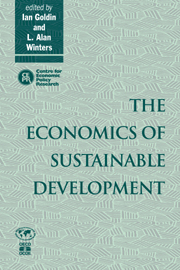Book contents
- Frontmatter
- Contents
- List of figures
- List of tables
- Preface
- Acknowledgements
- List of conference participants
- 1 Economic policies for sustainable development
- PART ONE GROWTH AND THE ENVIRONMENT
- PART TWO SUSTAINABILITY
- PART THREE DOMESTIC POLICY
- PART FOUR INTERNATIONAL POLICY COORDINATION
- 9 Carbon abatement, transfers and energy efficiency
- 10 Policy coordination for sustainability: commitments, transfers, and linked negotiations
- Discussion
- 11 Industrial competitiveness, environmental regulation and direct foreign investment
- Discussion
- Index
Discussion
Published online by Cambridge University Press: 04 August 2010
- Frontmatter
- Contents
- List of figures
- List of tables
- Preface
- Acknowledgements
- List of conference participants
- 1 Economic policies for sustainable development
- PART ONE GROWTH AND THE ENVIRONMENT
- PART TWO SUSTAINABILITY
- PART THREE DOMESTIC POLICY
- PART FOUR INTERNATIONAL POLICY COORDINATION
- 9 Carbon abatement, transfers and energy efficiency
- 10 Policy coordination for sustainability: commitments, transfers, and linked negotiations
- Discussion
- 11 Industrial competitiveness, environmental regulation and direct foreign investment
- Discussion
- Index
Summary
Outline and summary
How to expand the size of international coalitions for protecting the environment? This is the challenging issue tackled by the authors of chapter 10. They assume that coalition members take account of the social cost of emissions and agree to implement measures for abatement, so as coalition size increases more and more of the external effects of emissions are internalised: this is socially efficient. But, with the rising cost of abatement, the incentive to ‘free-ride’ becomes progressively more attractive: that is the problem. (Free-riders ignore transnational effects and set low abatement levels.)
To help sustain environmental coalitions, two solutions are considered. First, cash transfers for new entrants (financed by gains from environmental cooperation); second, linking environmental coordination to cooperation in other fields where there are positive externalities. In the economic model outlined in section 4.2, it is the opportunity to cooperate in industrial R&D which acts as the inducement to join the coalition. Indeed, if, as in Carraro and Siniscalco (1993), a specific linear-quadratic formulation is adopted, they find that the sustainable coalition can even expand to include all countries!
The first thing we do in our Discussion is to take precisely this linearquadratic formulation (which for convenience we refer to as the CS model) and to extend it by including positive externalities in the abatement technology itself. In this case we find that a global environmental coalition can in principle be self-sustaining without any linkage to cooperation in other fields.
The second point we make is to recommend the imposition of charges for emissions – something that seems to be omitted from the CS model.
- Type
- Chapter
- Information
- The Economics of Sustainable Development , pp. 283 - 288Publisher: Cambridge University PressPrint publication year: 1995



